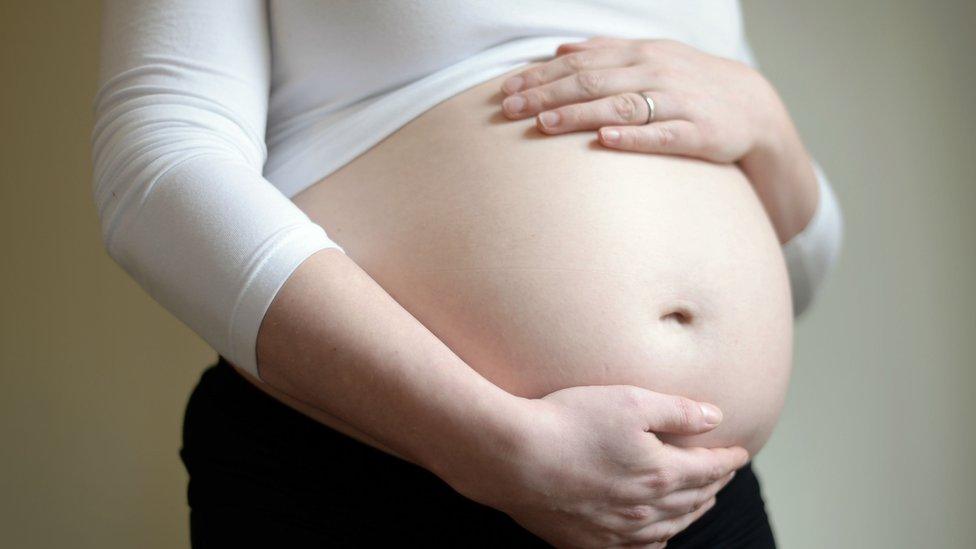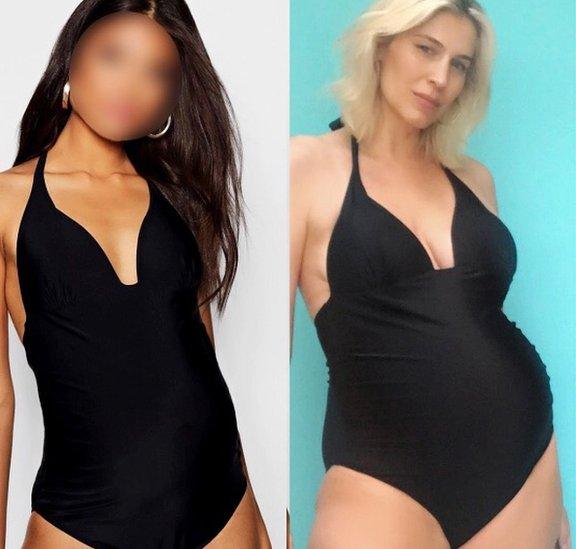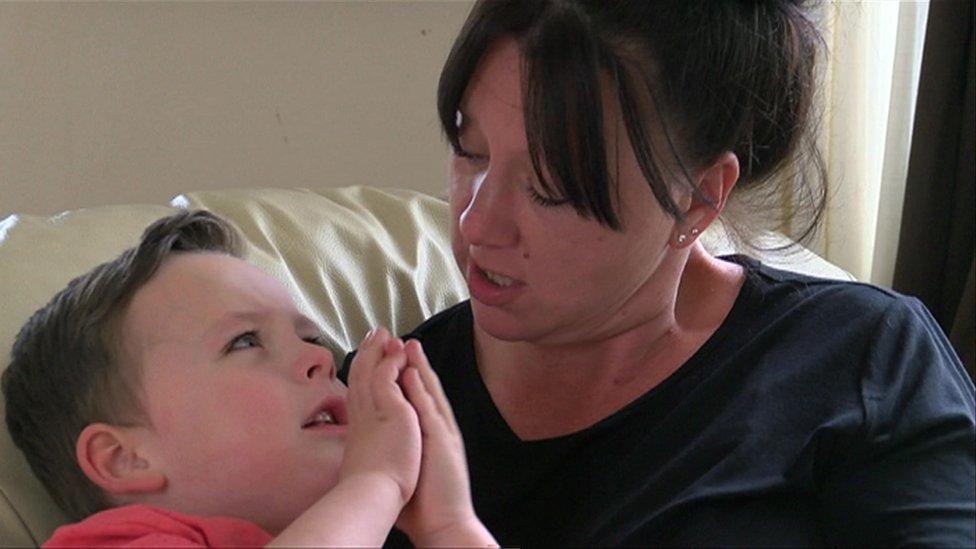Fashion firms criticised for using fake bump models
- Published

Pregnant models say they should model maternity clothes
Images of a Love Island contestant modelling maternity wear for Asos with a fake bump have fuelled an ongoing debate about pregnancy discrimination.
Critics say the use of prosthetics in maternity adverts puts unrealistic pressure on expectant mothers to look a certain way.
But some in the industry insist it is not always practical to cast only pregnant models for maternity shoots.
Asos said the prosthetics make it "easier for customers to compare fit".
It has also previously stated it does not want pregnant models to be on their feet all day.
The issue has made headlines after eagle-eyed fans of ITV's Love Island spotted pictures of 2019 contestant Arabella Chi modelling maternity clothing with a fake bump on the Asos website.
The online retail giant is reportedly not the only fashion business to use models wearing fake bumps.
In January, retailer Boohoo was accused on social media of using models wearing padding to advertise its maternity fashion.
Allow X content?
This article contains content provided by X. We ask for your permission before anything is loaded, as they may be using cookies and other technologies. You may want to read X’s cookie policy, external and privacy policy, external before accepting. To view this content choose ‘accept and continue’.

Model Sylvia Flote told the BBC she discovered it was common practice when she told her agency she was pregnant.
"As soon as I told my agency and said I wanted to do pregnancy shoots they told me most clients usually ask for non-pregnant girls," she said.
"I couldn't believe all these girls in the images are not actually pregnant."
The 36-year-old, who is pregnant with her first child, said she finds it depressing to look at these images as her own body is changing.
She explained: "You look online, trying to feel a bit better about your new look and you're presented with these girls, size 6 or 8, no changes in their bodies, but with a fake bump stuck on. It's totally unrealistic."

Model Sylvia Flote says being pregnant is 'not a disease'
Ms Flote wants retailers to use disclaimers, revealing whether a model is pregnant or not.
She believes clients worry that pregnant models will get tired, saying: "They think we're unwell but it's not a disease."
"Models are basically freelance, so if you're not getting work throughout your pregnancy and afterwards, that's a long time with no pay," she added.
The London-based Norwegian model told the BBC she knows some of her friends in the industry had modelled maternity clothing using a fake bump but, when they became pregnant themselves, were replaced by another non-pregnant model wearing a prosthetic.
Ms Flote said she has managed to work during her pregnancy for Next and Zara - both companies have a policy of using pregnant women to model their maternity ranges.
Next told the BBC: "We feel it is important to show the fit of our maternity wear on a pregnant model with a real bump as it is an accurate representation of how the clothing fits."
Marks and Spencer also told the BBC it always uses pregnant models.
A spokeswoman said: "We want to ensure that customers are seeing a real life model that allows them to accurately understand how those products will fit them."

Model and campaigner Louise Boyce posted this image of her modelling pregnancy underwear alongside a non-pregnant model on her blog mammastillgotit.com
Louise Boyce, who has been modelling for 23 years and is currently pregnant with her third child, is campaigning for honesty in maternity advertising.
Speaking to the BBC, she said: "It's ridiculous that pregnant models can't get work as a 'pregnant model'.
"I've been in studios with heavily-pregnant make-up artists and producers - nobody worried about them being on their feet all day.
"The truth is, brands want their maternity models to look a certain way."
Expectant mothers shopping online for clothes to fit their changing bodies are being driven to dieting and depression by these unrealistic images, according to Louise.
She said: "The average pregnant woman in the UK is a size 16 with a bump on top, plus expanding breasts, bottom, arms and ankles.
"Yet the majority of images selling us maternity clothes show a young, size 8 model with tiny breasts and a perfect bump who looks like she's just had a curry."

Ms Boyce also posted a picture of her wearing maternity swimwear alongside a model wearing a fake bump

Joeli Brearley, who founded pressure group Pregnant Then Screwed after she was sacked from her job when she was four months' pregnant, has joined forces with Ms Boyce on her #PushItOut campaign.
She believes the use of fake bumps puts enormous pressure on women to pursue an unrealistic appearance when pregnant.
She said: "It underlines the pressure placed on women to look a certain way, even when their body is performing a miracle - like making a baby - it is expected that your bump is the perfect shape."
Ms Brearley called the argument that it is to do with health and safety or helps consumers better compare clothing sizes "nonsense".
She said: "Asos and other retailers are using size 8 models and strapping a prosthetic bump to them because they think the clothes look better and they have a larger pool of models to choose from.
"This is discrimination, pregnant models are being refused work because they are pregnant, even though the job is for maternity wear - the irony is extraordinary."
Mums urge advertisers to be more realistic in their portrayal of pregnant women
And fashion commentator Lizzi Zita agrees it is always better to use pregnant women wherever possible for maternity shoots.
"Of course this is more ethical and make sense," she said.
But she warned it may not always be possible to get the right woman at the right stage of pregnancy at the time of shooting, and the production of photography needs to continue.
She added: "That said, as the industry becomes faster and faster, with two drops of new merchandise a month not unusual, it should not be difficult to employ real mums at a time when they could really use the extra income for the baby and all the equipment needed."
- Published22 May 2019

- Published24 January 2019

- Published30 January 2019
